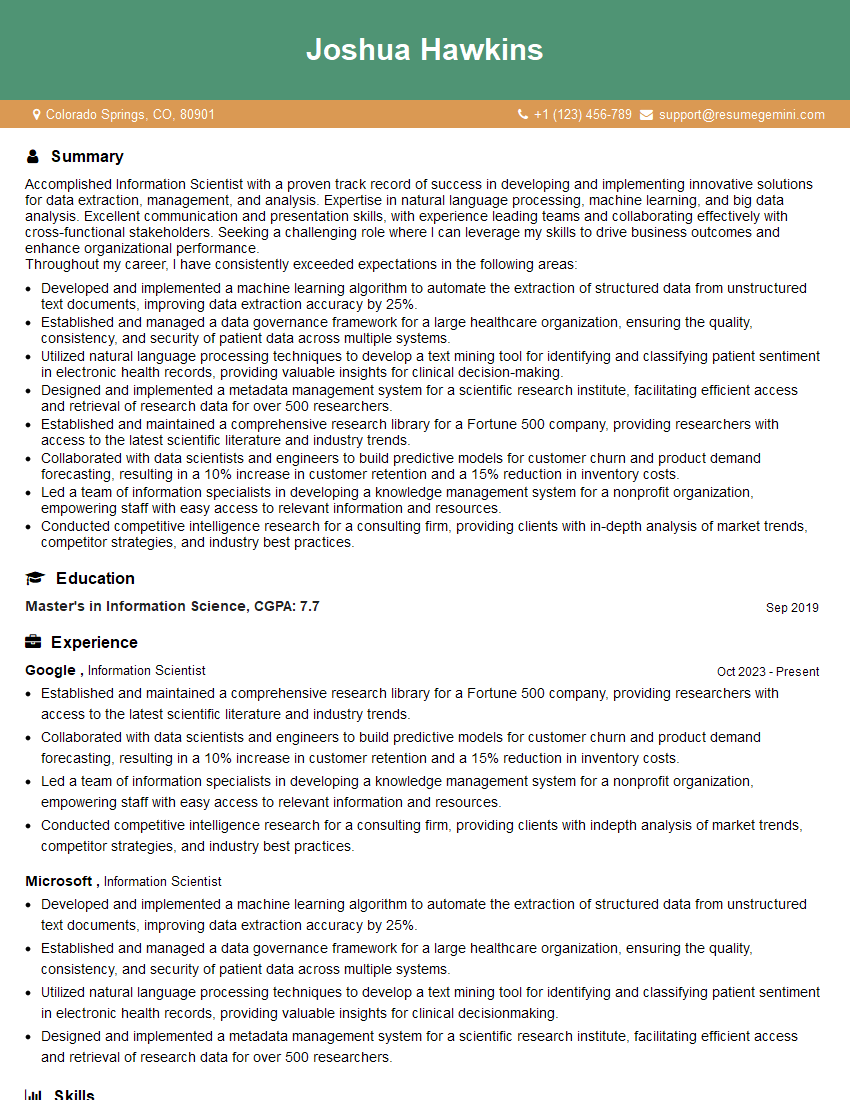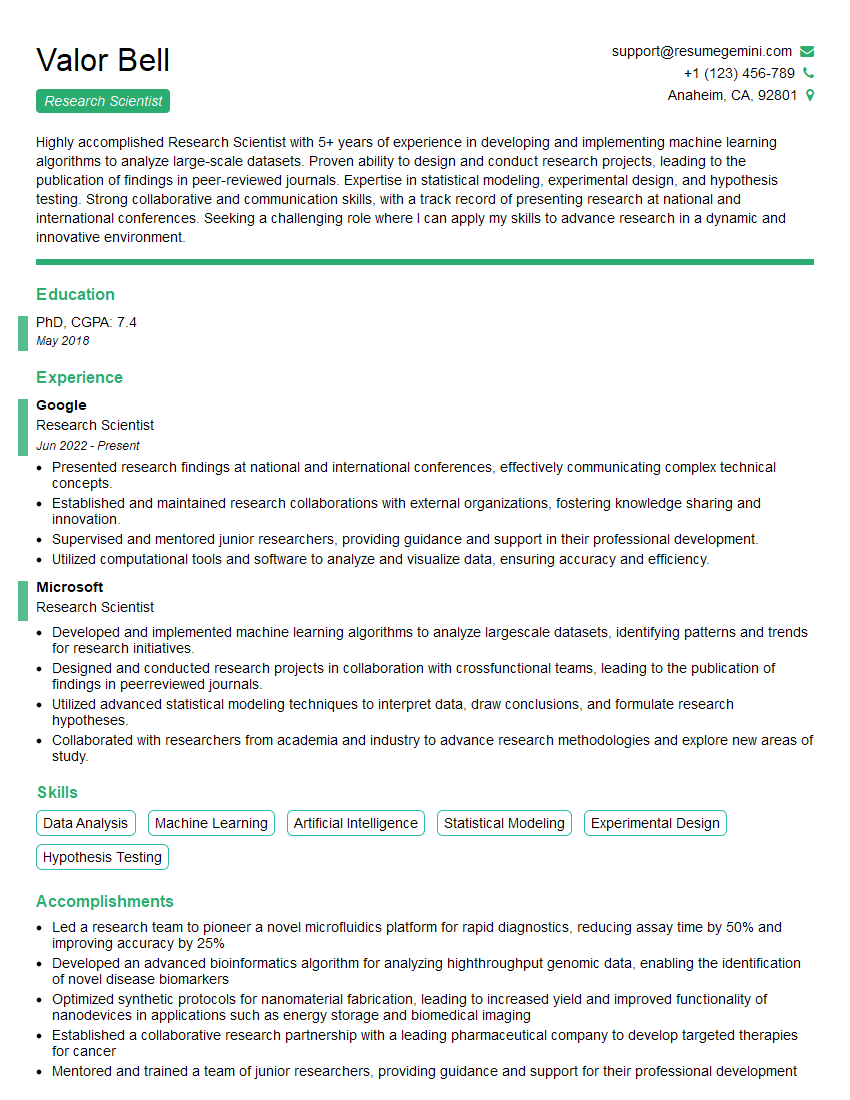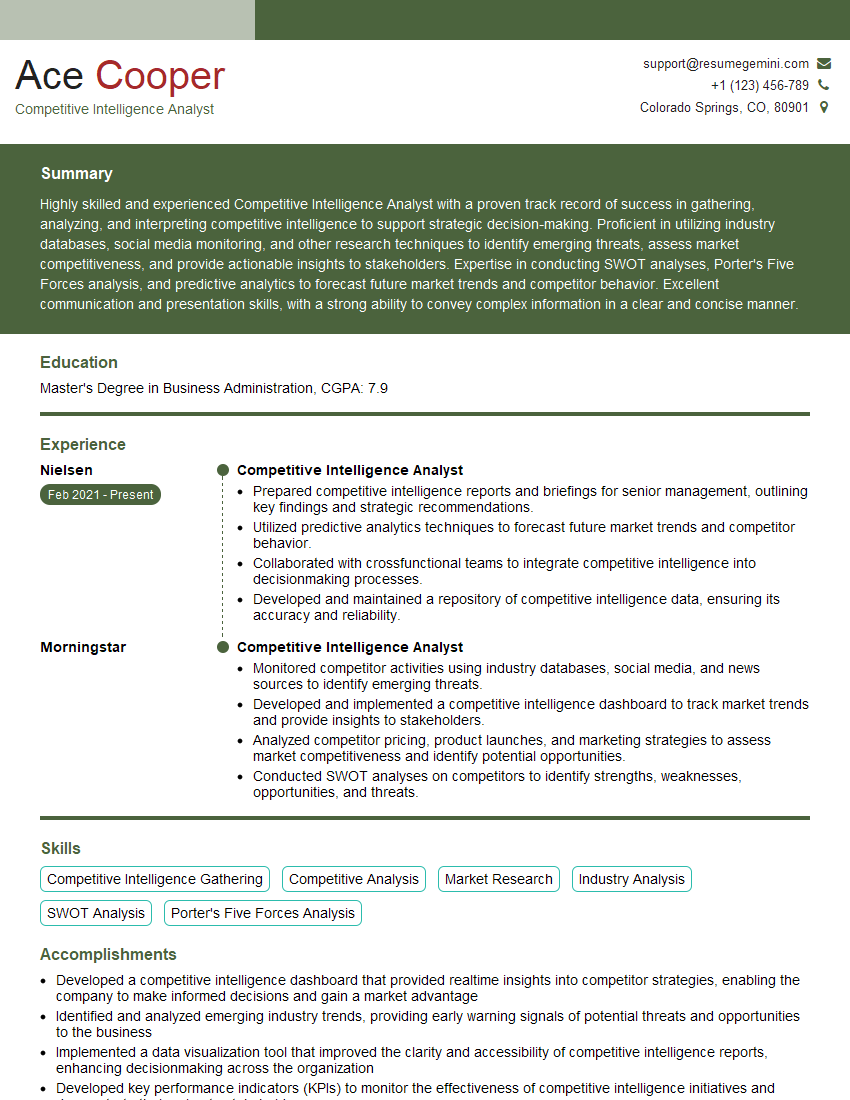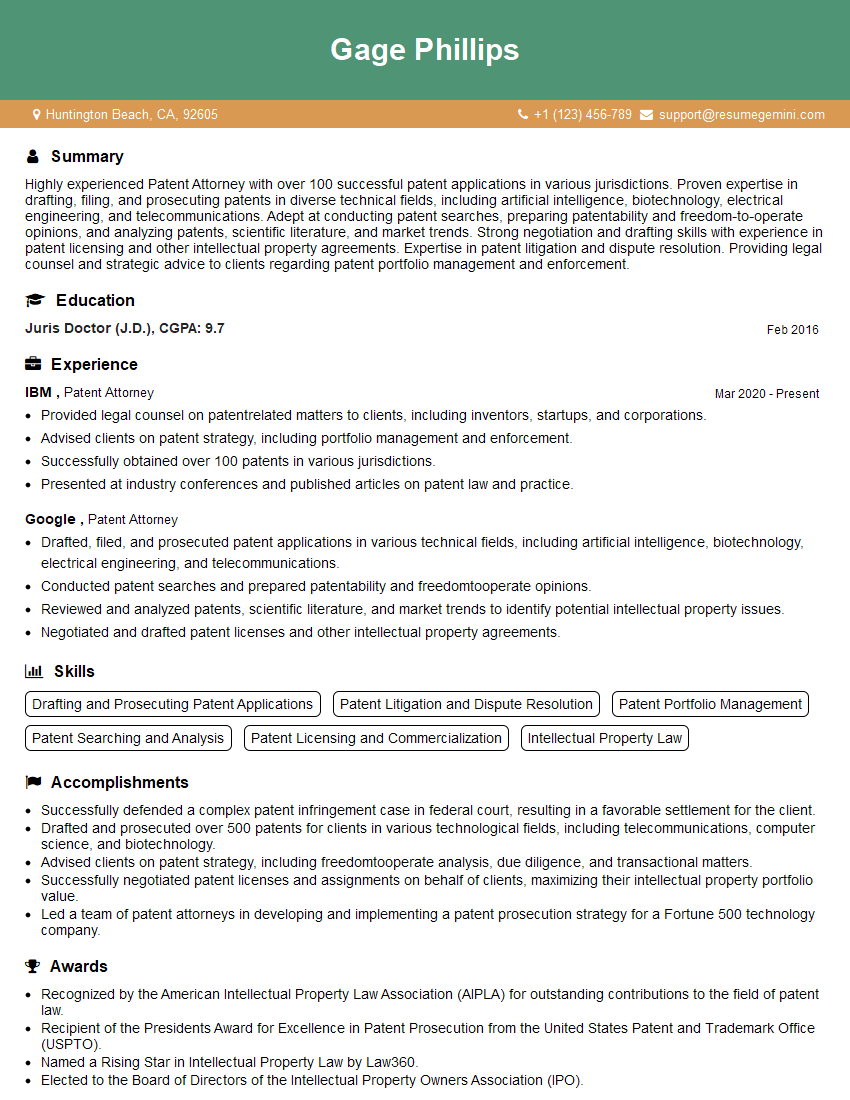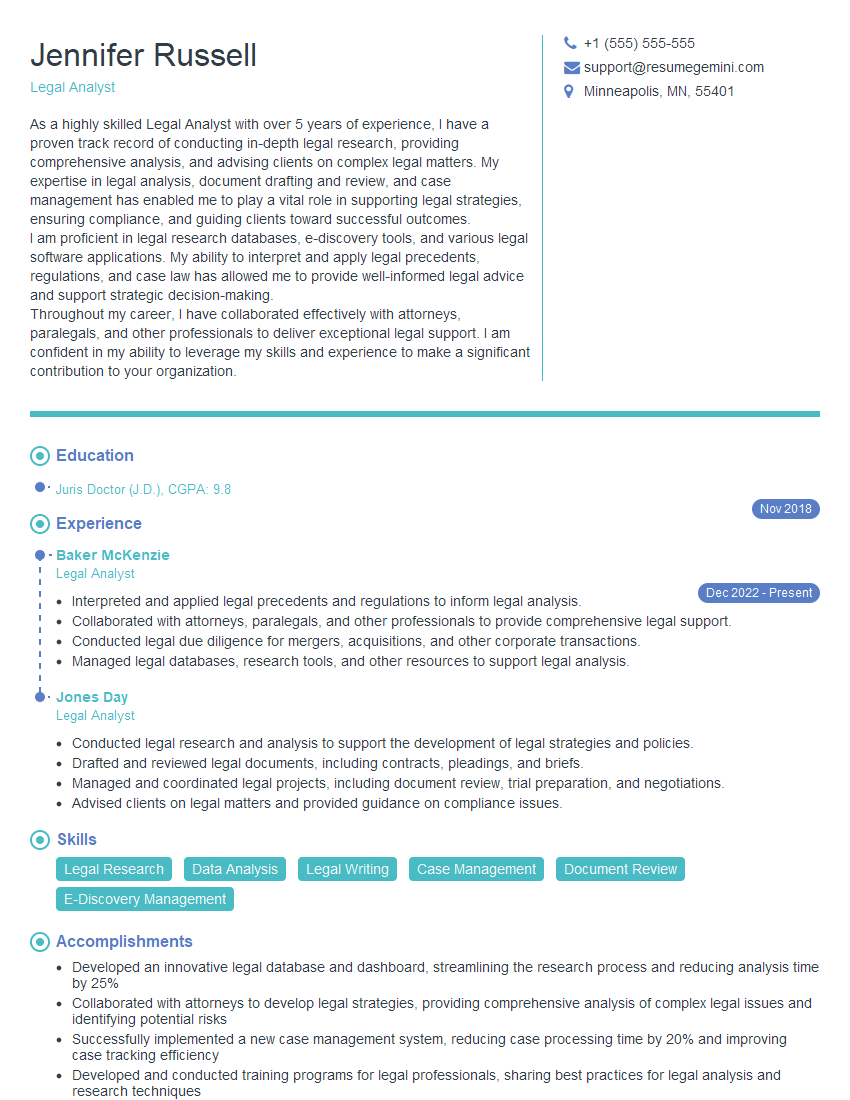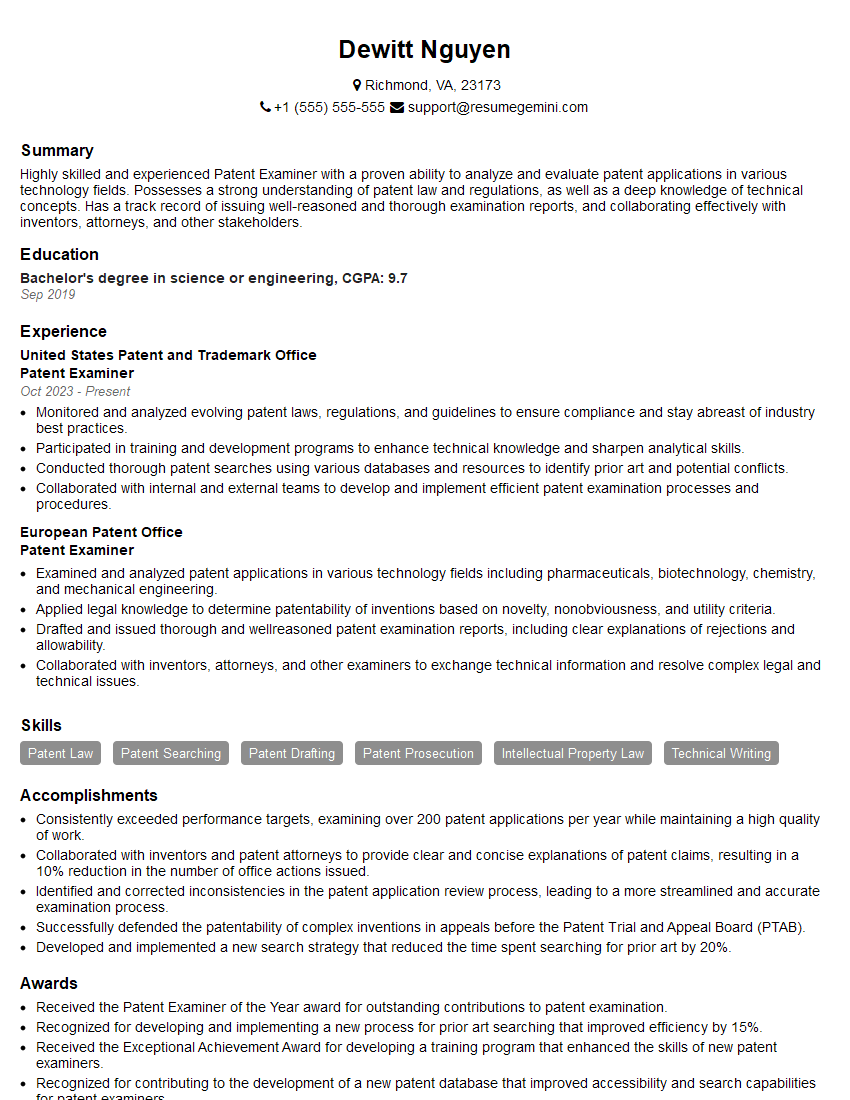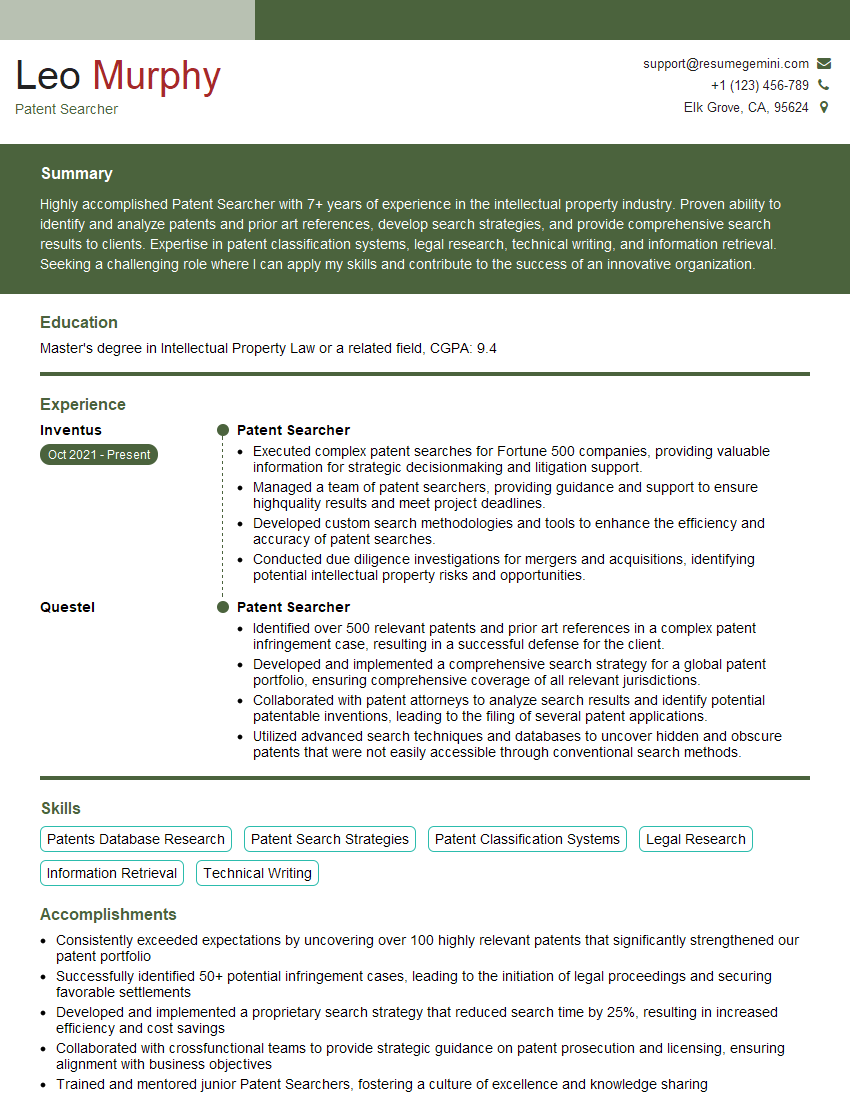Interviews are opportunities to demonstrate your expertise, and this guide is here to help you shine. Explore the essential Prior Art Analysis interview questions that employers frequently ask, paired with strategies for crafting responses that set you apart from the competition.
Questions Asked in Prior Art Analysis Interview
Q 1. Explain the importance of prior art analysis in the patent process.
Prior art analysis is crucial in the patent process because it determines the patentability of an invention. Essentially, it’s about identifying what already exists before claiming something as new and inventive. Without a thorough prior art search, a patent application might be rejected because the invention is already known or obvious to someone skilled in the art. A strong prior art search helps protect applicants from wasting time and resources on unpatentable inventions and reduces the risk of patent infringement lawsuits later on. It acts as a safeguard, ensuring that only genuinely novel and non-obvious inventions receive patent protection.
Imagine trying to build a house without checking if the land is already occupied – you’d face serious problems. Similarly, filing a patent without prior art analysis risks a rejection because someone else has already built a similar ‘house’ (invention).
Q 2. Describe different search strategies for identifying relevant prior art.
Effective prior art searches employ a multi-pronged strategy. It’s not just about keyword searches; it requires a combination of approaches. First, we start with keyword-based searches, using both general and highly specific terms related to the invention. Then, we use classification searches, leveraging the International Patent Classification (IPC) and Cooperative Patent Classification (CPC) systems to find patents categorized similarly to the invention. Next, citation searching helps; we look at the cited references of patents already found to discover related prior art. Finally, forward citation searching involves identifying patents that cite a key piece of prior art to uncover newer, related technologies. This ensures we cover a broader landscape of relevant information, not just what directly matches the initial search terms.
For example, if the invention is a new type of solar panel, the search will not only include keywords like ‘solar panel’, ‘photovoltaic’, ‘efficiency’, but also explore IPC and CPC classifications related to energy conversion, semiconductor devices, and materials science. We will then use the cited references of relevant patents found initially, and look for patents citing those documents.
Q 3. What databases do you utilize for prior art searches?
My prior art search strategy leverages a wide range of databases, including:
- Google Patents: A free and easily accessible database.
- Espacenet: The European Patent Office’s comprehensive database.
- USPTO’s Patent Full-Text and Image Database: The US Patent and Trademark Office’s primary resource.
- Web of Science: Covers scientific publications and journals.
- ScienceDirect: Another valuable resource for scientific and technical literature.
- IEEE Xplore: Focuses on electrical engineering and computer science literature.
The specific databases I use depend heavily on the technical field of the invention. For example, a biomedical invention would necessitate searches in PubMed and specialized biomedical databases in addition to the ones listed above.
Q 4. How do you assess the relevance of a prior art document?
Assessing the relevance of a prior art document is a critical step. It’s not enough to find documents; you must determine their significance to the invention’s patentability. I evaluate documents based on several factors:
- Disclosure of the same invention: Does the document describe the exact same invention as claimed? This includes the structure, function, and use.
- Anticipation: Does the document fully anticipate every element of the claim? This means the document’s disclosure is sufficient to enable a person skilled in the art to practice the invention without undue experimentation.
- Obviousness: Would the invention have been obvious to someone skilled in the art at the time of the invention, considering this document and the common general knowledge in the field? This assesses whether the invention represents a significant advancement.
- Date of publication or filing: The document must pre-date the invention’s filing date to be considered prior art. This establishes temporal priority.
This is a nuanced process; sometimes, a seemingly irrelevant document can become highly relevant when considered alongside other pieces of prior art. The assessment requires careful consideration of the claim language and a thorough understanding of the technical field.
Q 5. Explain the difference between novelty and non-obviousness.
Novelty and non-obviousness are distinct but related concepts in patent law. An invention is novel if it is not anticipated by the prior art. This means no single prior art document discloses the invention in its entirety. Non-obviousness, on the other hand, focuses on whether the invention would have been obvious to a person having ordinary skill in the art (PHOSITA) at the time the invention was made, considering the totality of the prior art. An invention can be novel but still obvious, and thus not patentable.
Think of it this way: novelty is about whether something is new, while non-obviousness is about whether it’s also inventive or surprising. You can have something new (novel) that isn’t a surprising leap forward (obvious). A simple modification of an existing product might be novel but not non-obvious.
Q 6. How do you handle conflicting prior art documents?
Conflicting prior art documents are common. When faced with this, a careful analysis is crucial. I would first attempt to reconcile the conflicting information. Perhaps one document is more relevant due to its disclosure or date. Often, one document might have limitations or inaccuracies that the other does not. If the conflict cannot be resolved through analysis, I’d prioritize the document that most strongly anticipates the claimed invention or renders the invention obvious. This analysis would be meticulously documented and presented with supporting reasoning to justify the conclusions. In some cases, further investigation might be required to find additional prior art that helps clarify the situation or even helps establish the patentability of the invention despite the conflicting references.
Each situation is unique. A structured approach and thorough documentation are vital.
Q 7. Describe your experience with different types of prior art (e.g., patents, publications, products).
My experience encompasses a wide range of prior art types. I’ve worked extensively with patents from various jurisdictions (US, Europe, etc.), using databases like Espacenet and the USPTO’s database. I’ve analyzed scientific and technical publications from journals, conference proceedings, and online repositories like Web of Science and ScienceDirect. Furthermore, I have considerable experience analyzing physical products; I have taken apart devices and examined their components to understand their structure and functionality, comparing them to the claims of a patent application. This hands-on approach allows for a thorough understanding of the technical aspects and ensures all relevant prior art is identified, regardless of the format.
For instance, in a case involving a new type of medical device, I would search patent databases for relevant patents and also seek information on similar devices in technical publications and even medical device market literature. Similarly, for software-related inventions, I would analyze related source codes and online documentation in addition to patents and publications.
Q 8. How do you determine the scope of a prior art search?
Defining the scope of a prior art search is crucial for its effectiveness. It’s like searching for a specific book in a vast library; a poorly defined search will lead to wasted time and potentially missed relevant information. The scope is determined by carefully considering the invention’s claims and the technology space it occupies.
- Claims Analysis: Start by meticulously analyzing the patent application’s claims. These claims define the boundaries of the invention. Each claim element needs to be translated into search terms. For example, if a claim mentions ‘a method for filtering water using a novel membrane material,’ search terms would include ‘water filtration,’ ‘membrane,’ and potentially specific membrane material types.
- Technology Classification: Use classification systems like the Cooperative Patent Classification (CPC) or International Patent Classification (IPC) to identify relevant technology areas. These systems organize patents by subject matter, guiding the search to the most appropriate patent databases and reducing the search space.
- Keyword Selection: Develop a comprehensive list of keywords encompassing synonyms, related terms, and alternative technical expressions. Think like an inventor who might approach the problem differently – consider different terminology and possible applications.
- Timeline Definition: Decide on a relevant time frame for the search. This is influenced by factors such as the novelty requirements of the jurisdiction and the invention’s development history. A broader timeline increases the search effort but improves the chances of finding highly relevant prior art.
For example, searching for prior art related to a new type of solar panel would involve analyzing the claims (e.g., material composition, efficiency metrics, manufacturing process), using CPC codes for solar energy technologies, and compiling keywords such as ‘photovoltaic,’ ‘solar cell,’ ‘silicon,’ ‘perovskite,’ and ‘efficiency’.
Q 9. What are some common pitfalls to avoid during prior art searches?
Prior art searches are prone to several pitfalls. Avoiding these requires meticulous planning and execution.
- Insufficient Keyword Research: Using too few or overly specific keywords can lead to missing relevant documents. A robust search strategy requires a diverse keyword set.
- Ignoring Non-Patent Literature: Focusing solely on patents is a significant mistake. Publications, conference papers, and even news articles can reveal valuable prior art. A comprehensive search should encompass all relevant document types.
- Language Barriers: Not searching in multiple languages can lead to overlooking crucial prior art published in other languages.
- Incomplete Database Coverage: Some databases are more comprehensive than others. Restricting the search to a single database risks missing relevant information.
- Failure to Validate Findings: After identifying potential prior art, thoroughly review each document to assess its actual relevance and avoid false positives.
- Bias and Confirmation Bias: It’s crucial to maintain objectivity. A preconceived notion about the novelty of an invention can lead to overlooking contradictory evidence.
For instance, relying solely on English-language databases when searching for prior art in the field of medicine, where significant research is published in languages like Mandarin or German, could severely limit the search’s effectiveness.
Q 10. How do you present your prior art findings to stakeholders?
Presenting prior art findings to stakeholders requires clear, concise, and impactful communication. It’s about clearly conveying the implications of the findings on the patentability or commercial viability of the invention.
- Executive Summary: Begin with a brief overview highlighting the key findings and their overall significance, even before diving into the technical details.
- Prior Art Summary Table: Create a table summarizing each identified piece of prior art, including the citation, publication date, key features, and its relevance to the invention’s claims.
- Claim Charting (if applicable): If the prior art directly addresses the claims, visual representation using a claim chart can significantly improve understanding.
- Visualizations: Use diagrams, figures, and flowcharts to illustrate the technical aspects of the prior art and how it relates to the invention. A picture is worth a thousand words.
- Impact Assessment: Clearly articulate the potential impact of the findings on the patentability, freedom-to-operate, and commercial strategy.
- Q&A Session: Allow time for questions and discussion to address any stakeholder concerns.
Think of it like presenting a business case; you need to build a strong narrative that convinces stakeholders of your findings. You might use a traffic light system (green, yellow, red) for prior art items, where red indicates a highly problematic piece of prior art that significantly limits the scope of patentable subject matter.
Q 11. How do you prioritize different pieces of prior art?
Prioritizing prior art is crucial for efficient decision-making. The prioritization strategy should reflect the specific goals of the search, which might be patentability analysis or freedom-to-operate assessment.
- Relevance to Claims: Prior art directly addressing the claims of the invention should be prioritized. The more claim elements a piece of prior art addresses, the higher its priority.
- Disclosure Level: Prior art that discloses features identical or very similar to those claimed should be prioritized over those that disclose only peripheral or tangential aspects.
- Publication Date: Prior art published before the invention’s priority date is significantly more relevant for assessing novelty and non-obviousness.
- Credibility of the Source: Prior art from reputable sources and publications is given more weight than information from less credible sources.
- Jurisdictional Considerations: The relevance of prior art may vary depending on the jurisdiction. Prior art published in relevant jurisdictions holds more importance.
Imagine a stack of cards, each representing a piece of prior art. The cards directly hitting the core aspects of the invention (like the strongest claim elements) would go to the top of the stack. Those only tangentially related would go to the bottom.
Q 12. How familiar are you with claim charting?
I am highly familiar with claim charting. It’s a critical tool in prior art analysis, especially when assessing the novelty and non-obviousness of an invention. Claim charting is a visual representation that maps the elements of a patent claim against the features disclosed in a piece of prior art. This technique allows for a clear comparison, highlighting whether the prior art anticipates or renders obvious the claimed invention.
A claim chart typically includes the independent claims as columns and the features of the prior art reference as rows. Each cell shows whether a specific feature of the prior art is disclosed in the claim or not, using symbols or check marks. This facilitates a quick assessment of the extent of the overlap between the prior art and the claims, helping determine the patentability of the invention.
Example: A simplified claim chart might use '+' to indicate disclosure, '-' to indicate no disclosure, and '?' for uncertain disclosure. This structured approach minimizes ambiguity and strengthens the analysis.
Q 13. Explain the concept of ‘closest prior art’.
The ‘closest prior art’ refers to the single piece of prior art that comes closest to anticipating or rendering obvious the invention in question. It represents the most significant hurdle to patentability. It’s not necessarily the single prior art document that teaches every element of the invention but the one that embodies the combination of features most similar to the claimed invention. Identifying the closest prior art is crucial for determining the patentability of an invention and is a critical step in evaluating novelty and non-obviousness. In some cases, this may involve combining multiple pieces of prior art, an idea often described as a ‘mosaic’ approach.
Finding the closest prior art requires careful comparative analysis of multiple documents. The selection criteria consider several factors such as the degree of similarity to the claims, the disclosure level, and the publication date. Often it is not a single piece of prior art, but it is also a combination of various prior art documents that together teach all the elements of the invention (the mosaic approach).
Q 14. How do you handle situations where relevant prior art is in a different language?
Handling prior art in different languages requires a multifaceted approach that ensures comprehensive coverage. Ignoring foreign language documents can severely limit the effectiveness of a prior art search and lead to inaccurate conclusions.
- Translation Services: Utilize professional translation services to translate abstracts and relevant sections of the document. Direct translation of the entire document might not be necessary in many cases.
- Bilingual Searchers: If feasible, engage searchers fluent in the relevant languages. This allows for nuanced understanding of the technical terminology and context, which is often lost in machine translation.
- Specialized Databases: Some databases provide access to foreign-language patents and publications with translation options, reducing reliance on external services.
- Keyword Adaptation: Adapt keywords into the target language to broaden the search scope.
- Careful Review: Always carefully review the translated content, considering the potential for errors or misinterpretations.
For example, if relevant prior art is published in Japanese, professional translation services should be utilized to accurately assess its contents for relevance and potential impact on the patentability of the subject invention. A skilled translator would also understand the nuances of the technical language used in the prior art document, leading to a more comprehensive analysis.
Q 15. What is your experience with using Boolean search operators?
Boolean search operators are the fundamental building blocks of effective database searching, particularly crucial in prior art analysis. They allow you to refine your search results by combining keywords with logical operators like AND, OR, and NOT. Think of them as precise tools to sculpt your search from a broad net to a finely targeted spear.
For example, searching for “medical device AND imaging” will only return results containing both terms. Using “medical device OR diagnostic” will broaden the search to include documents with either term. Finally, “medical device NOT software” excludes results mentioning software, focusing the search on purely hardware-related devices. My experience spans years of using these operators across various patent databases like Espacenet, Google Patents, and USPTO databases, significantly improving the efficiency and accuracy of my prior art searches.
I’ve found that mastering the use of wildcard characters (*) and proximity operators (like NEAR) is equally important. Wildcards broaden search terms to find variations (e.g., *imaging* finds “imaging,” “image,” “imagery”), while proximity operators find terms appearing close together in a document, reflecting stronger relevance.
Career Expert Tips:
- Ace those interviews! Prepare effectively by reviewing the Top 50 Most Common Interview Questions on ResumeGemini.
- Navigate your job search with confidence! Explore a wide range of Career Tips on ResumeGemini. Learn about common challenges and recommendations to overcome them.
- Craft the perfect resume! Master the Art of Resume Writing with ResumeGemini’s guide. Showcase your unique qualifications and achievements effectively.
- Don’t miss out on holiday savings! Build your dream resume with ResumeGemini’s ATS optimized templates.
Q 16. How do you verify the accuracy and completeness of your prior art search?
Verifying the accuracy and completeness of a prior art search is paramount. It’s not just about finding documents; it’s about ensuring you haven’t missed anything crucial. My approach is multi-faceted:
- Multiple Database Search: I never rely on a single database. I systematically search across multiple databases (e.g., USPTO, Espacenet, Google Patents, specialized databases) to maximize coverage.
- Systematic Keyword Selection: I develop a comprehensive list of keywords and synonyms, considering various spellings and terminology, including those from different technical fields. I use concept mapping and brainstorming techniques to ensure thoroughness.
- Classification Codes: I utilize patent classification systems (CPC, IPC) to identify relevant technology areas and explore related classifications, potentially uncovering documents missed by keyword searches alone.
- Forward and Backward Citation Searching: Once I have an initial set of documents, I use citation searching to find documents that cite my initial findings (forward citations) and documents cited by my initial findings (backward citations). This helps to uncover related and potentially missing prior art.
- Expert Review: In complex cases, I involve subject matter experts to validate the search strategy and results, ensuring that the results are both complete and relevant to the specific technological field.
This multi-pronged approach significantly enhances the confidence in the completeness and accuracy of my prior art search, mitigating the risks associated with incomplete or inaccurate findings.
Q 17. Describe your experience with different patent classification systems.
I have extensive experience working with various patent classification systems, primarily the Cooperative Patent Classification (CPC) and the International Patent Classification (IPC). The CPC is a more recent and hierarchical system offering greater specificity than the IPC. Understanding these systems is crucial because they structure patent information, enabling efficient searching by technology area. Think of them as organizing a vast library, allowing you to pinpoint relevant sections instead of searching blindly.
My experience includes using these classifications not just for searching but also for understanding the technological landscape. Analyzing the distribution of patents across different CPC or IPC classes helps to assess the competitive landscape and identify emerging technologies. I’ve utilized this in many projects, for example, identifying clusters of patents within a specific CPC class to understand technological trends within a niche market. I also often use the classification codes to identify potential competitors working in adjacent technological areas.
Q 18. How do you stay up-to-date on changes in prior art search techniques and technologies?
Staying current is essential in the dynamic field of prior art searching. My strategies involve a combination of active learning and networking:
- Professional Development Courses and Webinars: I regularly participate in online courses and webinars offered by organizations like the AIPLA (American Intellectual Property Law Association) and the IPO (Intellectual Property Office) to stay abreast of new techniques and technologies.
- Industry Publications and Journals: I subscribe to and actively read industry publications and journals focusing on intellectual property and information retrieval. This keeps me informed about advancements in search methodologies and database technologies.
- Conferences and Workshops: Attending conferences and workshops provides invaluable networking opportunities and allows me to learn from experts in the field. These events often feature presentations on cutting-edge search techniques and software.
- Professional Networking: I actively network with colleagues and other professionals in the field, sharing insights and best practices. Informal discussions often reveal practical tips and tricks that aren’t widely publicized.
This continuous learning approach ensures I’m proficient in the latest tools and techniques, leading to more effective and efficient prior art searches.
Q 19. Explain the difference between a prior art search and a patent landscape analysis.
While both involve searching for prior art, a prior art search and a patent landscape analysis differ significantly in scope and objective. A prior art search is a focused investigation to identify documents relevant to the *patentability* of a specific invention. Its main goal is to determine if the invention is novel and non-obvious.
In contrast, a patent landscape analysis takes a broader perspective, examining the *competitive environment* surrounding a specific technology or market. It aims to identify key players, technologies, trends, and potential opportunities and threats. A landscape analysis might cover several patents, research papers, and even market reports, providing a comprehensive view of the field.
Think of it this way: a prior art search is like examining a single piece of a jigsaw puzzle to see if it fits, while a patent landscape analysis is like looking at the entire puzzle to understand the bigger picture.
Q 20. How do you determine the validity of a patent based on your prior art findings?
Determining patent validity based on prior art findings involves a thorough analysis of the identified documents. It’s not just about finding prior art; it’s about demonstrating that the prior art anticipates or renders obvious the claimed invention. This involves a careful comparison of the patent claims with the prior art references.
I would evaluate the prior art based on several factors, including:
- Anticipation: Does the prior art disclose every element of the claimed invention? If so, the patent is anticipated and invalid.
- Obviousness: Would the claimed invention have been obvious to a person of ordinary skill in the art at the time the invention was made, based on the combination of prior art references? This often involves considering the teachings of multiple references and their combined effect.
- Enablement: Does the prior art sufficiently describe the invention to enable a person of ordinary skill in the art to practice it? If the claimed invention is not enabled by the prior art, it might still be valid.
My analysis would include a detailed report outlining the prior art references, the relevant claims, and the reasons why the prior art anticipates or renders the claims obvious or non-enabled. This report is crucial for supporting an opinion on the validity of the patent.
Q 21. How would you approach a prior art search for a novel software invention?
A prior art search for a novel software invention requires a nuanced approach due to the unique nature of software patents. Software is often described in functional terms, and the prior art might not always be explicitly documented in the same way. I would structure my approach as follows:
- Identify Key Functionality: Start by clearly defining the core functionality of the software invention. Break down the software into its key modules and algorithms.
- Keyword Development: Develop a robust list of keywords based on the functionality, algorithms, data structures, and programming paradigms used. This would include specific programming languages, libraries, and frameworks.
- Database Selection: Use a combination of general patent databases and specialized databases such as those focusing on computer science and software engineering. Consider searching databases containing technical literature like conference proceedings and journals.
- Free-Text Searching and Boolean Operators: Combine keyword searching with free-text searching to identify potentially relevant documents that might not be easily categorized.
- Consider Source Code: If possible, search for open-source projects and code repositories like GitHub to find relevant prior art. This can reveal similar functionalities or implementations.
- Functional Claims Analysis: Focus on analyzing the functional claims, as software patents often rely on describing what the software *does* rather than precisely *how* it does it.
This systematic approach increases the likelihood of identifying relevant prior art, particularly in the rapidly evolving field of software development.
Q 22. Describe your process for creating a prior art report.
Creating a comprehensive prior art report involves a systematic process. It starts with a thorough understanding of the invention, meticulously defining its key features and functionalities. This forms the basis for crafting effective search terms. Next, I employ a multi-faceted search strategy, utilizing various databases like Google Patents, Espacenet, and specialized databases relevant to the technology area. This involves keyword searches, classification code searches, and even citation searching to uncover related documents. I then meticulously review the retrieved documents, carefully analyzing claims, descriptions, and figures to identify any potentially relevant prior art. Finally, I synthesize my findings into a structured report, presenting the most relevant documents, highlighting their similarities and differences to the invention in question, and providing an overall assessment of novelty and non-obviousness. Think of it like detective work – piecing together clues from various sources to build a complete picture.
For example, if analyzing a new type of bicycle helmet, I would search for patents and publications related to bicycle helmets, head protection, impact absorption materials, and relevant safety standards. My report would then systematically present the most relevant prior art pieces, comparing their features to the claimed invention, highlighting any similarities and differences, and ultimately assessing the patentability based on the identified prior art.
Q 23. How do you deal with time constraints in conducting a prior art search?
Time constraints are a common challenge in prior art searches. To efficiently manage time, I employ a prioritized search strategy. This involves initially focusing on the most critical aspects of the invention, identifying core claims and functionalities. I start with broader searches using general keywords, then progressively narrow my focus using more specific search terms as I identify potentially relevant documents. I also leverage automated search tools effectively, using Boolean operators and filters to refine my results. Additionally, I strategically allocate my time by prioritizing databases based on their relevance to the technology area and their historical track record of yielding relevant results. Using a combination of automated tools and a structured approach, I can significantly reduce search time without compromising the thoroughness of my analysis. Think of it like a chess game; every move should be calculated to maximize efficiency and yield the best results.
Q 24. What are the ethical considerations related to prior art analysis?
Ethical considerations in prior art analysis are paramount. The most crucial aspect is maintaining objectivity and integrity. I must conduct my searches thoroughly and without bias, regardless of the desired outcome. This means meticulously documenting all search strategies and results, ensuring transparency and reproducibility. It’s also essential to accurately represent the findings, neither overstating nor understating the significance of any prior art. Confidentiality is another critical aspect; I handle all client information with utmost care, ensuring the protection of sensitive data. Failure to uphold these ethical standards can lead to misleading conclusions and have serious legal repercussions. Imagine it as building a house on a solid foundation – ethical practice lays the groundwork for a robust and reliable prior art analysis.
Q 25. How do you interpret and utilize legal precedent in your analysis?
Legal precedent plays a vital role in prior art analysis. I meticulously review relevant case law, paying close attention to how courts have interpreted patentability criteria like novelty and non-obviousness in similar technological areas. These precedents provide valuable guidance in assessing the likelihood of obtaining patent protection. For example, understanding how courts have handled the issue of obviousness in the context of combining known elements is crucial in evaluating whether an invention is truly inventive. By incorporating this legal perspective, I can better anticipate how a patent examiner or a court might interpret the prior art in relation to the invention being considered. It’s akin to using a legal roadmap, guiding the analysis and improving the accuracy of patentability predictions.
Q 26. How do you use prior art analysis to inform patentability decisions?
Prior art analysis is the cornerstone of patentability decisions. By identifying relevant prior art, I can assess whether an invention is novel and non-obvious. If the invention is found to be anticipated or rendered obvious by the prior art, it’s unlikely to be patentable. However, if the prior art reveals a gap or an inventive step not previously addressed, this strengthens the case for patentability. The analysis guides strategic decisions, such as claim drafting, where we might modify claims to avoid the closest prior art, or even deciding whether to pursue a patent application at all. It’s essentially a risk assessment, helping to determine the likelihood of success in obtaining and defending a patent.
Q 27. How would you prepare a presentation for non-technical stakeholders on your prior art findings?
Presenting prior art findings to non-technical stakeholders requires a clear and concise approach. I avoid technical jargon, using simple language and visual aids like diagrams and charts to explain complex concepts. The presentation starts with a brief overview of the invention, followed by a summary of the prior art’s relevance. I focus on the key similarities and differences between the invention and the closest prior art, emphasizing the implications for patentability. I highlight the key findings in a non-technical way, such as by stating the overall patentability assessment – whether the invention appears novel and non-obvious in light of the prior art. The goal is to provide a clear and actionable understanding of the prior art’s impact on the commercial viability of the invention.
Q 28. Explain your experience with using automated prior art search tools.
I have extensive experience using automated prior art search tools, including both commercial platforms like Derwent Innovation and free resources like Google Patents. These tools significantly enhance efficiency by automating keyword searches, Boolean searches, and classification code searches. I am proficient in employing advanced search strategies using Boolean operators (AND, OR, NOT) and wildcards to refine search results and minimize irrelevant hits. I regularly use filters based on publication date, inventor, and other relevant criteria to further focus the search. However, I’m acutely aware of the limitations of automated tools. They cannot fully replace the human element of interpretation and critical analysis. I always perform a thorough manual review of the results, ensuring I understand the nuances and context of each document before forming conclusions. Think of automated tools as powerful assistants, augmenting my analytical abilities, but never replacing my judgment and expertise.
Key Topics to Learn for Prior Art Analysis Interview
- Patent Databases and Search Strategies: Understanding different patent databases (e.g., USPTO, Espacenet, Google Patents) and developing effective search strategies using keywords, classifications, and Boolean operators. Practical application: Conducting thorough prior art searches for a hypothetical invention.
- Identifying Relevant Prior Art: Differentiating between truly relevant prior art and irrelevant documents. This involves critical evaluation of claims, specifications, and drawings to assess novelty and non-obviousness. Practical application: Analyzing a set of patent documents to determine their relevance to a given invention.
- Claim Construction and Interpretation: Understanding how patent claims are interpreted and the importance of claim language in determining the scope of protection. Practical application: Comparing claims from different patents to identify potential infringement or overlap.
- Freedom to Operate (FTO) Analysis: Assessing the risk of patent infringement associated with a product or process. This involves identifying potentially conflicting patents and evaluating the strength of those patents. Practical application: Performing an FTO analysis for a new technology before launch.
- Patent Prosecution and Litigation: Understanding how prior art is used in patent prosecution (application process) and litigation (lawsuits). This includes understanding the role of prior art in invalidating or defending patents. Practical application: Analyzing prior art to determine the patentability of an invention or to challenge the validity of an existing patent.
- Legal and Ethical Considerations: Understanding the legal and ethical responsibilities involved in conducting prior art searches and analysis, including maintaining confidentiality and avoiding misrepresentation.
Next Steps
Mastering Prior Art Analysis is crucial for a successful career in intellectual property, opening doors to exciting roles in patent law, technology development, and innovation management. A strong resume is your key to unlocking these opportunities. To make sure your skills and experience shine, create an ATS-friendly resume that highlights your expertise. ResumeGemini is a trusted resource that can help you build a professional and effective resume tailored to the specific requirements of Prior Art Analysis positions. Examples of resumes tailored to this field are available to guide you. Invest the time to craft a compelling resume – it’s an investment in your future career success.
Explore more articles
Users Rating of Our Blogs
Share Your Experience
We value your feedback! Please rate our content and share your thoughts (optional).
What Readers Say About Our Blog
Hi, I represent an SEO company that specialises in getting you AI citations and higher rankings on Google. I’d like to offer you a 100% free SEO audit for your website. Would you be interested?
good

